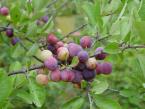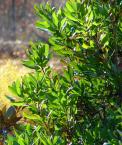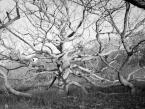The Polly Hill Arboretum’s herbarium collection began in 2001, with a gift of algae specimens from Island resident and seaweed expert, the late Rose Treat. A herbarium is a scientific resource consisting primarily of a collection of dried, pressed plant specimens. Herbarium specimens record the past and provide users with the historic and current locations of plants over time. Arboreta and botanical gardens use these reference collections for numerous research activities, including plant identification, verification and validation; documentation of the distribution and rarity of vulnerable plant populations; documentation of environmental changes; development of local floras and keys; genetic analysis, and the examination of plant/insect interactions.
The Arboretum has embarked on a long-term effort to catalog all the vascular plants that grow naturally or that were introduced on-Island. The procedure is arduous and involves carrying a plant press out in the field, collecting plant samples and then drying them to mount on acid free paper for long-term storage. The individual pressed dried plants are called voucher specimens. With each voucher specimen is accompanying ecological and habitat information. These specimens and the data document the physical occurrence and distribution of plants over time. The information is stored in our plant records database and shared with local, state, regional and national conservation organizations.
Approximately 3,400 herbaria exist today, with an estimated 350,000,000 specimens that document the earth’s vegetation for the past 400 years. In the truest sense, a pressed plant specimen captures a moment or snapshot in the history of biological time. Now, in the face of climate change and the potential calamity it may bring, pressed plant specimens help tell a story. Strong evidence of a rapidly warming earth has been assembled by several scientific institutions using the flowering times recorded from herbarium specimens dating back over the past two hundred years. Specimens typically record flowering times as flowers are the central identifying feature for most species. Two trends are strikingly evident; in general plants are flowering a week to 10 days earlier than in the past, and distribution of several distinctly southern species are migrating north.
Here on the Vineyard our recent collections reveal that many more invasive plants have reached our shores and are spreading rapidly. In addition to these unwelcome newcomers, we have added several new Island records of native plants. Additional efforts are focused on historical plants, or plants that have not been recorded over the past 60 years. We are fortunate to have the help of key plant conservation partners on the Island who are contributing to this assessment. Sheriff’s Meadow Foundation, The Nature Conservancy and the Martha’s Vineyard Land Bank are all participating in the long-term project. At some point the Arboretum will have a very detailed, comprehensive herbarium collection. This will provide landowners, conservationists and anyone interested in determining an unknown plant species a valuable reference collection to consult. This helpful service is just one positive aspect a botanical garden brings to the community that supports it.
Tim Boland is executive director of the Polly Hill Arboretum. This column appears each Tuesday in the Gazette.






Comments
Comment policy »